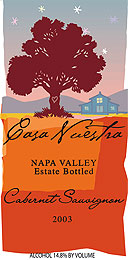

Casa Nuestra
2003 Cabernet Sauvignon, Estate(St. Helena ~ Napa Valley)
Casa Nuestra owner Gene Kirkham and winemaker Allen Price are producers who make finished wines in the old-fashioned way – and that’s a huge plus for my palette.
Here, we have a typical Cabernet Sauvignon that the iconoclastic Kirkham and Price have been turning out on the Silverado Trail since the 1970s. That is, I’m going to say it – wait for it – they make wines that are consciously intended to go with food. (Remember the rap that that phrase took back in the late ‘80s? Well, I think it’s about time to revitalize the notion in light of the fact that I think so many wines today are out of whack, and therefore, anathema to food.)
Anyway, this 2003 from a spotty vintage is just the ticket for lamb or beef, or even chingale. It’s in fine balance with fruit from 18-year-old, dry-farmed vines that impart raspberry and black cherry flavors common to a St. Helena Cab. It also has excellent acidity, which is tasting somewhat astringent at the moment. But that will integrate with time – let’s say two years out and for the next 15. The fine-grained tannins will lend a hand, too, ensuring that it will be a keeper.
The listed alcohol is a very manageable 13.9 percent, from grapes picked at 25.5 percent. The precise oak regimen is unspecified but French wood was used – and if I know Kirkham and Price – they used a goodly portion of neutral barrels. The only downside here is that a mere 90 cases were made.
Reviewed July 4, 2006 by Alan Goldfarb.
Other reviewed wines from Casa Nuestra
The Wine
Winery: Casa Nuestra |
The Reviewer Alan Goldfarb
Alan Goldfarb
Alan Goldfarb has been writing about and reviewing wine for 17 years. His reviews have been published in the St. Helena Star, San Jose Mercury, San Francisco Examiner, Decanter, and Wine Enthusiast, among others. Not once has he used a point system, star system, or an iconic symbol to quantify a wine. What counts in Mr. Goldfarb’s criteria when judging a wine is: how it tastes in the glass; is it well-constructed; its food compatibility; and presence of redeeming regional attributes. |











